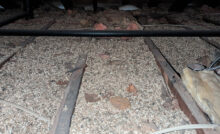Converting U Values To R Values


R values rate how much heat loss the material resists from passing through it, U-values rate how much heat the component allows to pass through it. R values rate one single material while U values measure entire components. For example R values measure how much heat loss passes through fiberglass insulation while U values rate how much heat can pass through a window component (glass, air, vinyl sash). Typical insulation might have an R value of 19 while a window might have a U value of 0.35.
Converting a U value of 0.35 to an R value is as simple as R = 1/U. So a U value of 0.35 would equal an R value of 2.86. As you can see from this example windows have a MUCH lower R value than a properly insulated wall. Most homes in the northeast are insulated with a minimum of R19 in the walls. Good windows these days boast a U value of 0.32 (or an R value of 3.13) thats approximately only 16% of the R value that’s in the wall. The lesson here is buy good windows but make sure you understand that the more area of glass you install the less efficient the total wall space will be when it comes to insulation.
Recent Posts
Framing Stick Nailer vs Coil Nailer
Which is Better a Stick Nailer or Coil Nailer? Framers have many choices in nailers…
How Many Roofing Nails Per Square of Shingles
Estimating How Many Nails for a New Roof When it comes to estimating materials for…
Composite / PVC Decking – Layout Tips & Advice
Composite / PVC Decking Layout Tips and Advice Composite and PVC decking have really changed…
Benefits of an ERV System (Energy Recovery Ventilator)
Benefits of ERV Systems (Energy Recovery Ventilator) If you're building a new home or doing…
Vermiculite Attic Insulation Abatement
Vermiculite Attic Insulation If your home was built before 1990 there is a chance it…
Nuisance Tripping of AFCI (Arc Fault) Circuit Breakers
Arc Fault (AFCI) Circuit Breakers Tripping Often An arc-fault circuit interrupter (AFCI) or arc-fault detection…

View Comments
R=19 would end up to a 70 cm thick wall.
Most recent european standard says a roof should be R=6, wich is impossible to meet without a minimum of 23-25cm thickness.
Same standard for wall is R=2,8
Passive housses, that doesn't need heating, requires R=8 for the roof and 3 for the wall.
I thick you made a mistake.
cheers.
@ Jimcoco - Actually there is no mistake. R19 would be 70cm thick if it were Glass.....i'm talking about how to compare glass U ratings to equivalent R values so you understand a comparison to insulation materials.
Todd:
Unfortunately, the "U" of a window is typically taken at the CENTER of the glass, not the entire composite.
Second, if the window does not have a tight air infiltration rating, (that is how many cubic feet of air infiltrate through the sash crack perimeter), the best "U" in the world will do nothing as the air infiltration negates the savings of the insulated glass. Unfortunately even the energy star people don't properly address this issue.
You are correct that the "U" is typically used for a window as if the "R" was the basis, people would see how poor almost every window is at insulating a building. Again, this is why air infiltration reduction is so important.
@ Tom - Very good point. Air infiltration is a huge factor to consider. We've been using some triple pane windows lately and they work very well.
According to NFRC all ratings are performance ratings of the entire window not just the glass and the frame around the glass can affect the rating. I agree with everything you say but your in conflict with what NFRC says about how performance ratings are done. Can you elaborate more, have I misunderstood you or NFRC?
Robert - You are correct and that is what I said in the article.
"U-values rate how much heat the component allows to pass through it. R values rate one single material while U values measure entire components."
Not sure what the confusion is? Also, it's really important to note that this is not a perfect science, more appropriately it's a simple estimate so that you can compare the two terms on an order of magnitude comparison.
I hope that helps.
Hi Todd.
http://www.sizes.com/units/rvalue.htm says: "To convert a European U-value to an American R-value, multiply by 0.176, then divide 1 by the result".
This differs from your example.
which is correct?
cheers
My example is correct for converting American U values to American R values.
That reference says to convert an European U-value to an American R-value: Divide 1 by (Multiply European U value by 0.176).
The confusion between American and European values would be solved if the units for the values were shown. The American ones are:
R-value (h °F ft2)/BTU
U-value BTU/(h °F ft2)
Metric ones are (essentially everywhere outside America):
R-value m2K/W
U-value W/m2K
so the 0.176 is to convert between the different units.
more info here:
http://en.wikipedia.org/wiki/R-value_(insulation)
Air infiltration is often ignored when talking about R and U values. I've found (through many remodels) that the very best time to insulate is cold windy winter days. You can feel the tiny breezes come in. Plug that hole more. Windows are especially hard to stop air around the jambs. R values mean nothing with air infiltration, so don't take the builder's word at that.
I caulk extension jambs to the window jamb and foam b/tween jamb and framing. Also feel the air come in around receptacles and light switches. Small cracks add up. Builder's don't take time to do these things.
Dave - Couldn't agree more with you! One of the very best ways to improve the insulation envelope is caulking every single joint....sill plate to floor, stacked studs, any place that can't be insulated well.